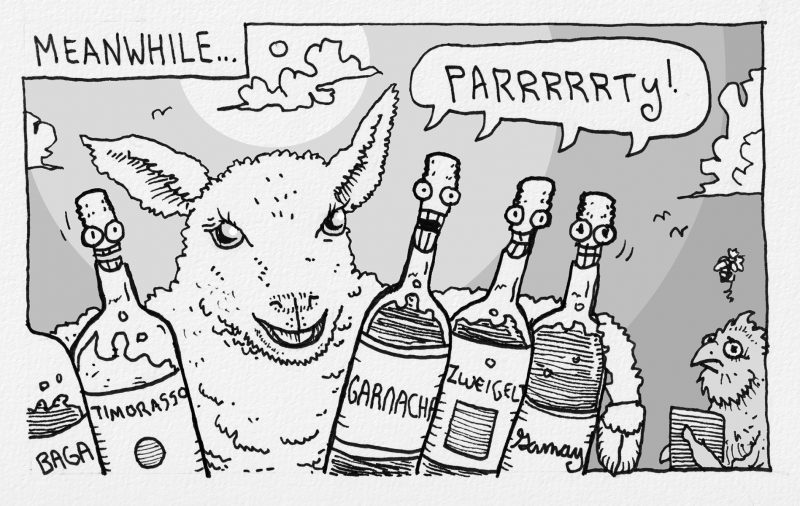Comic strip credit: Fish Griwkowsky
This article originally appeared in the Fall 2021 print issue of Quench Magazine.
PEOPLE I KNOW AGONIZE OVER WHAT WINE TO SERVE WITH CERTAIN FOODS.
MY ADVICE —DON’T.
Sure, there are classic combinations in which the food and the wine seem to act synergistically to enhance the overall pleasure; briny oysters with Chablis or Muscadet leap to mind. I wish I knew more about the science of taste. But what I do know is that there’s more to it than just what’s on the table.

In Florida, some years ago, I stopped by a cavernous wine shop to pick up a bottle on our way to a seafood shack that had great fish, but an abysmal wine list. My heart skipped a beat when I spotted a Jacques Prieur Meursault Clos de Mazeray. Prieur is a top Burgundy producer and Clos de Mazeray, while not a premier cru, is owned entirely by them (a monopole) and is one of their stellar white wines. I hurriedly snagged one of the few remaining dark green bottles and headed to dinner. We got to the restaurant, they chilled the bottle, popped the cork, and poured. Imagine my surprise when I saw the color. Unbeknown to me at the time, about ten percent of the Clos de Mazeray is planted with Pinot Noir. So, there I was, with a red Burgundy to accompany stone crab followed by grilled pompano. Not a choice I would have made, but it worked. It taught me that people make more of matching wine to food than they should.
Why did that red Burgundy work with sea-food? Because it’s not only the food and wine that determines the enjoyment. Sure, it helped that both the wine and the food were stellar. But equally important, and sometimes more important, is the setting and company.
Picture this: you and your spouse or significant other are on vacation in the South of France or the Amalfi Coast. You’re sitting on a highly acclaimed restaurant’s flowered terrace overlooking an azure-blue Mediterranean. The weather is perfect. I venture to say that any wine you have with dinner will be divine. In this instance, the setting far outweighs the particular food or wine. Even insipid rosés are memorable in this context.
A recent meal reminded me of the importance of company. At dinner, my two nephews and I started with a lovely bottle of 2004 Drouhin Chablis Les Clos. We sat down and continued with it when the oysters arrived. I thought the power and chiseled minerality of the Chablis would be an ideal match with my striped bass swimming in a sauce Barigoule (Provencal sauce of artichokes, Mediterranean herbs, and white wine) that I had ordered. The 1978 Château Meyney, an earthy, but suave, St. Éstephe, that we had brought would be fine with my nephews’ duck breasts. By the time the mains had arrived, the Chablis was, not surprisingly, gone, and I was forced to drink ’78 Meyney with fish. You know what? It was a memorable dinner. Why? Because it was the renewal of our monthly dinners after a 15-month Covid-19 hiatus and the high that accompanied it. It hardly mattered what was on the table. The wine was excellent, the fish was superb. I don’t even remember whether the Meyney and my fish meshed. It was all about who was around the table and our emotional state.
If there was a lesson learned it was to consider the setting and the people before obsessing about which wine to serve. Bob Harkey, owner of Harkey’s Fine Wines, a top-notch shop in Millis, Massachusetts, just west of Boston, once gave me excellent advice about selecting wine for Thanksgiving, a meal at which there’s a plethora of flavors on the table: “Match the wine to the guests, not to the food.”
Even without the memorable setting or the special company, wine and food can be strange bedfellows. Earlier this year I was tasting 30 Corton-Charlemagne from Domaine Louis Latour for a five-decade vertical tasting I wrote about for another article. Although I had many of those wines with the customary “white wine dishes,” seafood or chicken in a cream sauce, to name just two, I did wind up drinking some of them with the not immediately obvious pairings of grilled rib-eye steak, coq au vin, and other “red wine dishes.” But they worked. Yes, some were mature, 20 and 30-year old, Grand Cru wines with depth of flavor, and some were youthful. More importantly, they all had brilliant acidity and freshness, which it turns out, is what you need regardless of what’s on your plate. Most importantly, the wines were so damn good that eating most anything would have been fine.
So, my advice is to ignore, or at least, recon-sider, the so-called rules you may have heard. They may have had relevance in the past before fusion cuisine exerted such an influence on modern dining and the food was more sharply defined, but now, with so many cross-cultural influences in play on the dinner plate, it’s time to rethink your options.
Also, please discard the generalizations you might have heard about which single type of wine works with the food from a specific country. The cuisine of India is so varied—are we speaking of relatively mild Tandoori chicken or a fiery hot lamb vindaloo—that the advice that Gewürztraminer “works with Indian food” is both meaningless and wrong. Similarly, the flavors within Chinese food range from delicately prepared seafood common to Cantonese cooking, to the mouth-singeing Mongolian hotpot, so do you really think a single specific type of wine will be perfect with Chinese food?
At a seminar matching Sauternes with Chinese food at VinExpo a few years ago, Jeannie Cho Lee, a Hong-Kong based MW, pointed out a critically important, but often overlooked, element. The Western attendees were pontificating about the pairings. At the end, Lee diplomatically noted in a low-keyed, but decisive voice, what in retrospect should have been obvious, that it’s difficult for a Western palate to relate to how Eastern palates react to foods. So, what Westerners think is a marvellous food and wine combination may not work around the world.

As is apparent, I dislike rigidity about food and wine pairing. There’s no need for self-imposed restrictions or fear that something might not be the perfect pairing, whatever that means. And, indeed, sometimes you are wowed by the wine and then enjoy the food. They are rarely in your mouth at the same time. The only way you’ll know if a particular wine works with a dish is to try it. So, feel free to wing it. For those who might feel reluctant to “wing it,” at least initially, here’s some very general advice.
First, decide whether the food or the wine is more important. For wine geeks who are opening a treasured old wine, such as a decades-old Bordeaux or Barolo, choose a simply prepared meal, a grilled steak or a rack of lamb. An unadorned grilled swordfish steak for that 20-year Grand Cru white Burgundy is another example. No complicated sauces or preparations that add additional flavors to the plate are needed. The wines are the centerpieces in this instance. Let them speak.
For the vast majority of people, the food comes first. In that instance, match the weight of the wine to the weight of the food. This often coincides with seasonal eating though there are plenty of meaty cuts on the grill in the summer. The acidity of the wine is paramount regardless of the season or the weight of the food. While low-acid wines may be preferable when sipping them as a stand-alone aperitif, think a glass-of-Chardonnay-as-a-cocktail kind of wine, it’s the acidity that makes your mouth water, refreshes the palate, and keeps the wine fresh and lively during a meal.
Heavy food, those stick-to-your-ribs winter stews, call for robust or rich reds. Lighter summertime fare calls for light reds or whites. For the grilled meats in summer, remember that it’s fine to chill reds. Chilling accentuates the astringency of the tannins, so chilling low-tannin reds, such as Beaujolais or Bardolino, is the way to go. Indeed, I prefer chilled reds to almost all rosés in the summer.
Next, consider the level of heat. The conventional advice, which I think remains valid, is that as the heat increases, so should the level of sweetness in the wine. Off-dry Riesling or Chenin Blanc is a good choice because they display a range of sweetness or fruitiness that will offset the fire. But other choices will work well in this setting, so feel free to experiment. Wines high in alcohol, such as Zinfandel or Grenache-based wine, to name just two, or those high in acidity, such as Barbera, also work well with fiery foods, especially meaty BBQ, because the alcohol lends sweetness and the acidity cuts through everything.
It’s difficult to generalize for dishes that feature spices that don’t singe the tongue, such as cinnamon, cloves, cumin, turmeric and the like, so present in contemporary cuisine. This is where experimentation can be even more rewarding.
You’ll notice I’ve omitted rosé. That’s not an oversight. More on that in a later column.
When in doubt, have Champagne or sparkling wine. It truly does go with everything. There’s the importance of acidity, again. And the sound of the popping cork transforms an evening from ordinary to special.
Michael Apstein has written about wine for over three decades. He received a James Beard Foundation Journalism Award in 2000 and was nominated again in 2004 and 2006. Dr. Apstein is an Assistant Professor of Medicine at Harvard Medical School and a member of the Division of Gastroenterology at the Beth Israel Deaconess Medical Center. He lectures and writes frequently about wine and health. When he is not traveling in Paris or Burgundy, he can be found dining at Troquet in Boston, or drinking red and white Burgundy as often as possible (plus Bordeaux, oh, and don’t forget Italian wines) at his home in Massachusetts.
